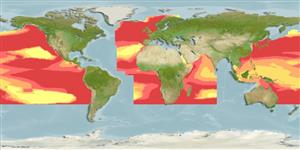>
Scombriformes (Mackerels) >
Bramidae (Pomfrets)
Etymology: Taractes: Greek, taraktes = confusion; for the pletora of names that have been applied to this fish (Ref. 45335).
More on author: Lowe.
Environment: milieu / climate zone / depth range / distribution range
Ecología
marino; oceanodromo (Ref. 51243); rango de profundidad 1 - 140 m (Ref. 58302). Temperate; 72°N - 35°S, 180°W - 180°E
Circumglobal: In tropical to temperate waters. Western Pacific: Japan (Ref. 559). Eastern Pacific: Alaska to southern California, USA. Eastern Atlantic: Madeira to Iceland and northern Norway (Ref. 6697); Cape Province, South Africa (Ref. 4388). Western Indian Ocean: southern Madagascar and Natal, South Africa (Ref. 4388); Maldives (Ref. 30829). Highly migratory species.
Tamaño / Peso / Age
Maturity: Lm ? range ? - ? cm
Max length : 50.0 cm SL macho / no sexado; (Ref. 6697)
Espinas dorsales (total): 0; Radios blandos dorsales (total): 31-34; Espinas anales 0; Radios blandos anales: 23 - 26. Lateral line generally present. Dorsal profile of head between eyes flat or slightly convex, not notably arched. Dorsal and anal fins with scales.
Occurs offshore in warm and temperate waters (Ref. 6697). May spawn widely in the subtropics (Ref. 6697).
Life cycle and mating behavior
Madurez | Reproducción | Puesta | Huevos | Fecundidad | Larva
Smith, M.M., 1986. Bramidae. p. 633-636. In M.M. Smith and P.C. Heemstra (eds.) Smiths' sea fishes. Springer-Verlag, Berlin. (Ref. 4388)
IUCN Red List Status (Ref. 130435)
Threat to humans
Harmless
Human uses
Más información
Nombres comunesSinónimosMetabolismoDespredadoresEcotoxicologíaReproducciónMadurezPuestaAgregación para la puestaFecundidadHuevosEgg development
ReferenciasAcuiculturaPerfil de acuiculturaRazasGenéticaElectrophoresesheritabilidadEnfermedadesProcesamientoNutrientsMass conversion
ColaboradoresImágenesStamps, Coins Misc.SonidosCiguateraVelocidadTipo de nataciónSuperficie branquialOtolitosCerebrosVisión
Herramientas
Special reports
Download XML
Fuentes de Internet
Estimates based on models
Preferred temperature (Ref.
123201): 6.7 - 27.9, mean 16 °C (based on 2326 cells).
Phylogenetic diversity index (Ref.
82804): PD
50 = 0.7500 [Uniqueness, from 0.5 = low to 2.0 = high].
Bayesian length-weight: a=0.01122 (0.00514 - 0.02450), b=3.04 (2.87 - 3.21), in cm total length, based on all LWR estimates for this body shape (Ref.
93245).
Nivel trófico (Ref.
69278): 4.2 ±0.6 se; based on size and trophs of closest relatives
Resiliencia (Ref.
120179): Medio, población duplicada en un tiempo mínimo de 1.4-4.4 años (Preliminary K or Fecundity.).
Fishing Vulnerability (Ref.
59153): Moderate vulnerability (44 of 100).
